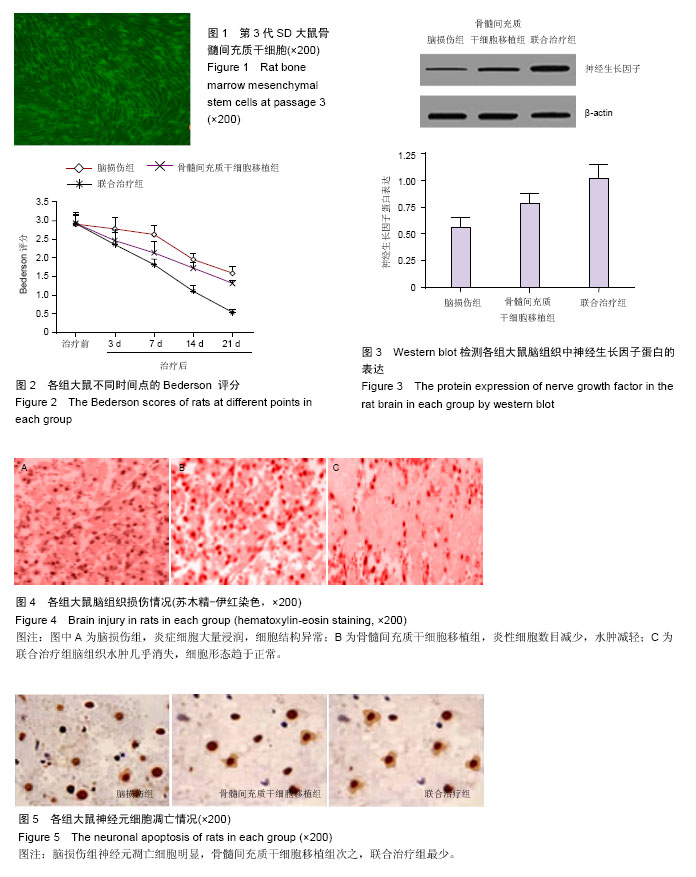| [1] Klose MC, Juul A, Poulsgaard L, et al. Pituitary insufficiency following head trauma. Ugeskr Laeger. 2007;169(3):211-213.
[2] Lingsma HF, Roozenbeek B, Steyerberg EW, et al. Early prognosis in traumatic brain injury: from prophecies to predictions. Lancet Neurol. 2010;9(5): 543-554.
[3] 先德海,余崇林.骨髓间充质干细胞治疗创伤性脑损伤的研究进展[J].泸州医学院学报,2012,35(3):337-339.
[4] Arabi YM, Haddad S, Tamim HM, et al. Mortality reduction after implementing a clinical practice guidelines-based management protocol for severe traumatic brain injury. J Crit Care. 2010;25(2):190- 195.
[5] Lee HC, Chuang HC, Cho DY, et al. Applying cerebral hypothermia and brain oxygen monitoring in treating severe traumatic brain injury. World Neurosurg. 2010; 74(6):654-660.
[6] Engelmann CM, Siert L. Cognitive disturbances following severe traumatic brain injury. Ugeskr Laeger. 2007;169(3):217-219.
[7] Liliang PC, Liang CL, Weng HC, et al. Tau proteins in serum predict outcome after severe traumatic brain injury. J Surg Res. 2010;160(2):302-307.
[8] Sekhon MS, Dhingra VK, Sekhon IS, et al. The safety of synthetic colloid in critically ill patients with severe traumatic brain injuries. J Crit Care. 2011;26(4): 357-362.
[9] Paxinos G, Waston C. The rat brain stereotaxic coordinates[M]. 2nd ed. New York: Academic Press Inc, 2010: 145-152.
[10] Azizi SA, Stokes D, Augelli BJ, et al. Engraftment and migration of human bone marrow stromal cells implanted in the brains of albino rats--similarities to astrocyte grafts. Proc Natl Acad Sci U S A. 1998; 95(7):3908-3913.
[11] Xiong Y, Mahmood A, Chopp M. Emerging treatments for traumatic brain injury. Expert Opin Emerg Drugs. 2009;14(1):67-84.
[12] 黄小平,王蓓,邱咏园,等.黄芪甲苷、人参皂苷Rg1、Rbl和三七皂苷R1抗小鼠脑缺血再灌注氧化应激损伤和促进能量代谢的配伍研究[J].湖南中医药大学学报,2014, 34(7):5-11.
[13] 罗欢,夏伦祝,段贤春,等.三七皂苷对缺血性脑损伤保护作用的研究进展[J].辽宁中医药大学学报,2011,13(10): 107-109.
[14] 江刘平,焦林如.三七总皂苷的药用生物学活性研究进展[J].氨基酸和生物资源,2013,35(3):17-21.
[15] 钟森,陈文超,徐永强,等. 三七总皂苷对脑缺血再灌注损伤大鼠神经干细胞相关调节因子及脑细胞凋亡的影响[J]. 中国中医急症, 2010, 19(2):279-281.
[16] 潘敏,李玛琳.中药及其提取纯化物对骨髓间充质干细胞诱导分化的研究进展[J].中国中药杂志,2010,35(14): 1892-1895.
[17] 詹合琴,张文熙,闫福林,等.三七皂苷Rg1对脑缺血损伤后大鼠脑组织凋亡因子表达的影响[J].广东医学,2014, 35(10):1478-1482.
[18] 冯士军,韩建国.RhoA基因沉默联合脐带间充质干细胞移植脑损伤大鼠功能的恢复[J].中国组织工程研究,2013, 17(1):23-30.
[19] 何志旭,严虎,刘俊峰,等.骨髓间充质干细胞移植治疗缺血再灌注脑损伤[J].中华实用儿科临床杂志,2013,28(6): 435-439.
[20] 王飞,潘庆刚,邓东风,等.胶质细胞源性神经营养因子基因修饰的神经干细胞移植治疗大鼠脑损伤[J].中华创伤杂志,2007,23(12):894-897.
[21] 程发峰,宋文婷,郭少英,等.三种神经功能评分在鼠类局灶性脑缺血模型评价中的比较[J].中国康复医学杂志,2011, 26(4):337-341.
[22] 李红星,苑国富,金耀东,等.神经干细胞移植联用神经节苷脂对脑损伤大鼠神经学功能恢复的影响[J].中国组织工程与临床康复,2011,15(40):7505-7510.
[23] 安雅臣,王玉浔,赵晓晶.静脉注射人脐血间充质干细胞对大鼠脑损伤细胞凋亡的影响[J].中华老年心脑血管病杂志,2013,15(11):1204-1207.
[24] 黄兴锐,朱云霞,赵爱琴,等.bFGF与骨髓间充质干细胞联合移植对脑损伤后神经再生的影响[J].神经解剖学杂志, 2009,25(2):129-134.
[25] 张翠香,刘建勋,董小霞,等.对凋亡细胞 TUNEL 染色操作中的体会[J].实验动物科学,2014,31(4):46-48.
[26] Zhang J, Li Y, Zhang ZG, et al. Bone marrow stromal cells increase oligodendrogenesis after stroke. J Cereb Blood Flow Metab. 2009;29(6):1166-1174.
[27] Nordenbo AM, Jakobsen JK. Rehabilitation of severe traumatic brain injury. Ugeskr Laeger. 2007;169(3): 197.
[28] Nadri S, Soleimani M, Mobarra Z, et al. Expression of dopamine-associated genes on conjunctiva stromal-derived human mesenchymal stem cells. Biochem Biophys Res Commun. 2008;377(2):423-428.
[29] Zhang J, Li Y, Zhang ZG, et al. Bone marrow stromal cells increase oligodendrogenesis after stroke. J Cereb Blood Flow Metab. 2009;29(6):1166-1174.
[30] Cho JS, Park HW, Park SK, et al. Transplantation of mesenchymal stem cells enhances axonal outgrowth and cell survival in an organotypic spinal cord slice culture. Neurosci Lett. 2009;454(1):43-48.
[31] Li LY, Li JT, Wu QY, et al. Transplantation of NGF-gene-modified bone marrow stromal cells into a rat model of Alzheimer' disease. J Mol Neurosci. 2008; 34(2):157-163.
[32] 冯士军.NGF 联合骨髓间充质干细胞移植治疗大鼠脑损伤[J].中国现代医学杂志,2011,21(8):924-928.
[33] Mothe AJ, Kulbatski I, Parr A, et al. Adult spinal cord stem/progenitor cells transplanted as neurospheres preferentially differentiate into oligodendrocytes in the adult rat spinal cord. Cell Transplant. 2008;17(7): 735-751.
[34] 谢平安,廖辉.三七对脑神经细胞作用机制的研究进展[J].云南中医中药杂志,2012,33(2):68-69.
[35] 严永兴,梁丽贞,周智林,等.三七三醇皂苷对大鼠局灶性脑缺血再灌注后不同恢复时期脑 梗死体积和Nogo-A表达的影响[J].中国中医药科技,2010,17(5):407-408.
[36] 陈俊萍,马祁生.三七三醇皂苷对脑缺血大鼠脑室下区细胞增殖及星形胶质细胞的影响[J].中国药房,2010,21(43): 4061-4063.
[37] Li HP.Qiang L,Zhang CY,et al.Publication trends in studies examining radix notoginseng as a treatment for ischemic brain injury.eural Regen Res. 2014; 9(17): 1635-1642.
[38] 乔春玲,丁艳芬,杨崇仁.三七总皂苷药理研究进展[J].中国现代中药,2012,14(11):25-30.
[39] He X,Deng fj,gE jw,et al.Effects of total saponins of Panax notoginseng on immature neuroblasts in the adult olfactory bulb following global cerebral ischemia/reperfusion. Neural Regen Res. 2015;10(9): 1450-1456.
[40] 李花,邓常青,熊艾君,等. 三七总皂苷对大鼠脑缺血再灌注后脑内NGF 和bFGF 表达的影响[J].现代生物医学进展,2008,8(2):219-221.
[41] 邓昌.三七总皂苷对局灶脑缺血再灌注海马中NGF及TrkA的影响[J].亚太传统医药,2009,5(2):26-28.
[42] 涂献坤,杨卫忠,石松生,等.黄芩苷抑制缺血性脑损伤大鼠脑组织TN-α和AQP-4表达及减轻脑损伤的研究[J].中国药理学通报,2013,39(9):1222-1225. |
.jpg)


.jpg)